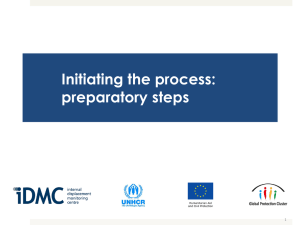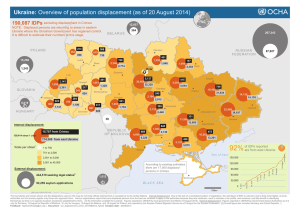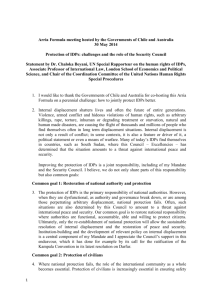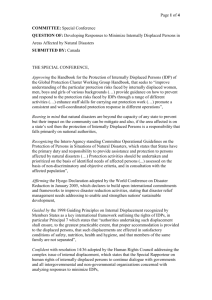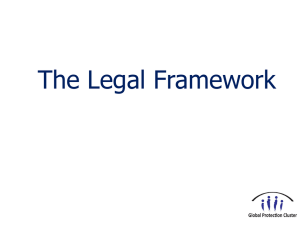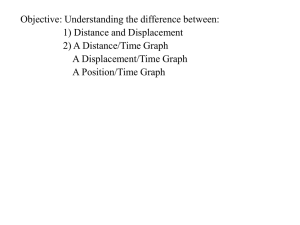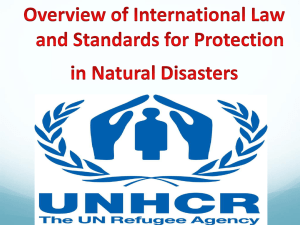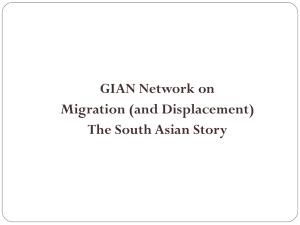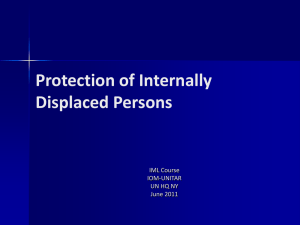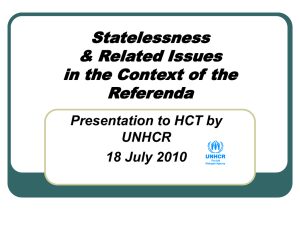The Guiding Principles on Internal Displacement
advertisement
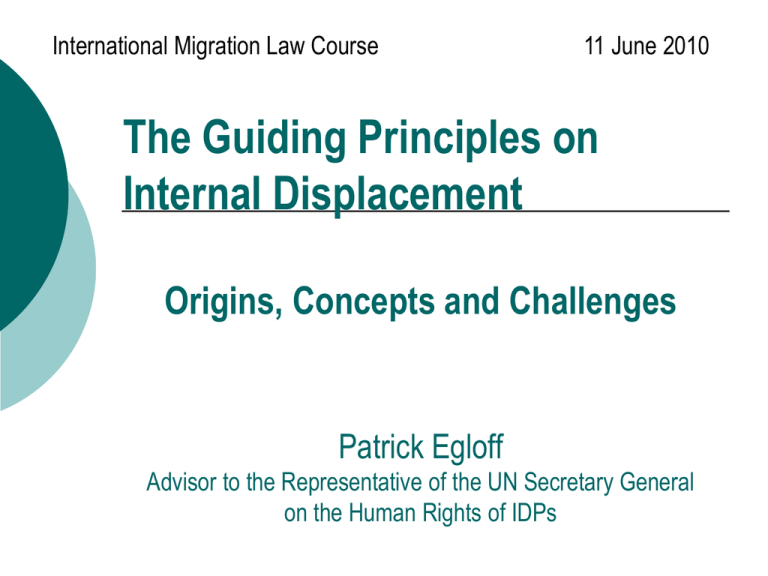
International Migration Law Course 11 June 2010 The Guiding Principles on Internal Displacement Origins, Concepts and Challenges Patrick Egloff Advisor to the Representative of the UN Secretary General on the Human Rights of IDPs Overview • Who is an IDP? • What is the present situation of internal displacement? • Do IDPs have rights? I. Who is an IDP? “... internally displaced persons are persons or groups of persons who have been forced or obliged to flee or to leave their homes or places of habitual residence, in particular as a result of or in order to avoid the effects of armed conflict, situations of generalized violence, violations of human rights or natural or human-made disasters, and who have not crossed an internationally recognized State border” II. The Present Situation Magnitude of the Problem 45 40 35 30 25 IDPs (armed conflict) Refugees 20 15 10 5 0 IDPs (other causes) ??? 27 million IDPs in 54 countries (Dec 2009): • Africa: 11.6 mio • Americas: 5 mio • Asia: 4.3 mio Europe: 2.4 mio Middle East: 3.4 mio Figures Largest internal displacement situations 2009: Sudan (4.9 mio), Colombia (3-4 mio), Iraq (2.7 mio), DRC (1.9 mio), Somalia (1.5 mio), Pakistan (1.2 mio) Major new displacement during 2009: Pakistan, Sudan, DRC, Philippines, Somalia Major return movements during 2009: Pakistan, DRC, Uganda, Sudan, Kenya © Norwegian Refugee Council IDPs have special needs ... Problems usually not faced by those who remain in their homes: Lack of shelter and problems related to camps Loss of property and access to livelihoods Discrimination because of being displaced Lack of identity cards Lack of access to services Lack of political rights Restitution of/compensation for lost property Problems of return and integration ... and are especially vulnerable IDPs run a higher risk than those remaining at home: to have their children forcibly recruited to become victims of gender-based violence to become separated from family members to be excluded from education to be without a job to be excluded from political participation. III. The Rights of IDPs: The Guiding Principles on Internal Displacement 1992: Creation of the Mandate of the Representative of the UN Secretary General on Internal Displacement 1994: Request to elaborate an “appropriate normative framework” 1998: Guiding Principles on Internal Displacement 2005: World Summit: Recognition as “important international framework for the protection” of IDPs The Guiding Principles on Internal Displacement Translated into more than 40 languages More than 10 countries incorporated them into national legislations or policies Endorsed at the regional level Convention of the African Union on Protection and Assistance to IDPs Conceptual ideas 1. Although internally displaced persons have departed from their homes, unlike refugees they have not left the country whose citizens they normally are: They can invoke all human rights and IHL guarantees available to the citizens of that country. Applicability of refugee law is not possible. 2. 3. 4. Internally displaced person experience a very special factual situation and, therefore, have specific needs. The GPs restate in more detail those legal provisions which respond to the specific needs of IDPs and make explicit guarantees protecting IDPS that are inherent in IHL and IHRL. Not a binding instrument but a highly authoritative document. Content Addresses all phases of displacement Section I: General principles (1-4) Section II: Protection from Displacement (5-9) Section III: Protection during Displacement (10-23) Section IV: Humanitarian Assistance (24-27) Section V: Post-Displacement Phase (28-30) General Principles IDP definition Principle of equality before the law Principle of non-discrimination Primary responsibility of the national authorities Prevention from displacement Prohibition of arbitrary displacement Based on policies of apartheid or ethnic cleansing In situations of armed conflict, unless the security of civilians or imperative military reasons so demand In cases of large-scale development projects not justified by compelling public interest In case of disasters unless the safety of persons requires their evacuation Four groups of relevant rights 1. Rights related to physical security and integrity (e.g., rights to life and to be free of torture, assault, rape, etc); 2. Basic rights related to basic necessities of life (e.g., the rights to food, potable water, basic health, shelter); 3. Rights related to other economic, social and cultural protection needs (e.g., the rights to work, receive restitution or compensation for lost property, and education); and 4. Rights related to other civil and political protection needs (e.g., the rights personal documentation, political participation, access to courts, and freedom of movement). Group 1: Right to physical security and integrity Right to life Right to dignity and integrity Principle 10 Art. 6 CCPR, common Art. 3 Geneva Conventions Principle 11 Art. 7 and 8 CCPR, common Art. 3 Geneva Conventions Protection against Principles 12 arbitrary deprivaArt. 9 CCPR and 14(2) tion of liberty Right to seek Art. 12 CCPR safety / protection Principle 15 Art. 3 CAT, Art. 7 CCPR against return Group 2: Right to basic necessities Right to food and water Principle 18 Art. 11 CESCR Right to shelter Principle 18 Art. 11 CESCR Right to clothing Principle 18 Art. 11 CESCR Right to basic health services Art. 12 CESCR Principle 19 Group 3: Other social, economic and cultural rights Right to education Principle 23 Art. 13 CESCR, 28 CRC, 4(3)(a) APII Property related Principle 21 rights 17 UDHR, regional Conventions, IHL Right to work Principle 22(2)(b) Art. 6 and 7 CESCR Some aspects of Principle 19 right to health Art. 12 CESCR Group 4: Other Civil and Political Rights Right to documentation Freedom of movement Principle 22 Art. 6 UDHR, art. 16 CCPR Principle 14 Art. 13 UDHR, art. 12 CCPR Additional information Brookings-Bern Project on Internal Displacement: www.brookings.edu/idp IDMC/NRC: www.internal-displacement.org Office of the UN High Commissioner for Human Rights http://www2.ohchr.org/english/issues/idp/index.htm Office of the UN High Commissioner for Refugees: www.unhcr.org
